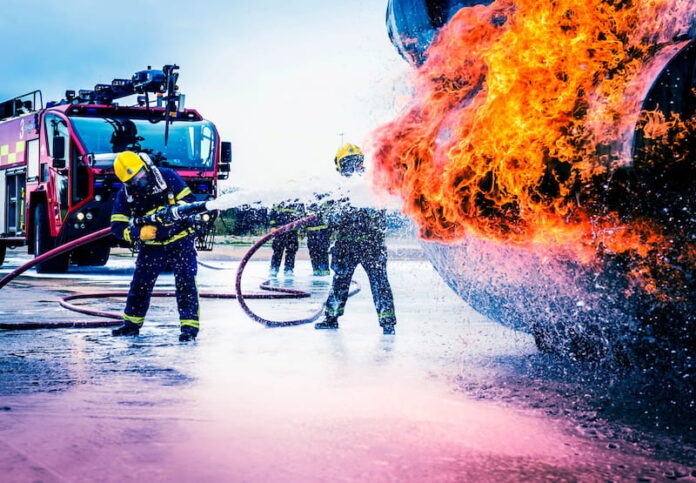Aqueous Film-Forming Foam, commonly known as AFFF, is a firefighting foam used for decades to suppress flammable liquid fires. AFFF is particularly effective for controlling fires involving fuels like gasoline and oil. The foam creates a blanket that cuts off the fire’s oxygen supply, preventing it from spreading. While AFFF is highly effective in firefighting, concerns have grown around its chemical makeup. AFFF contains per- and polyfluoroalkyl substances (PFAS), which are persistent chemicals known to accumulate in the environment and human body. Research has shown certain chemicals can be harmful. They may even cause cancer. For firefighters, who often use AFFF, understanding these risks is crucial.
What Is AFFF Made Of?
AFFF is composed of water, foam, and a combination of surfactants, which help form a film over the burning liquid. The critical ingredients in AFFF are PFAS, a group of synthetic chemicals known for their ability to resist heat, water, and oil. These chemicals do not break down easily and have earned the nickname “forever chemicals” because they remain in the environment for a long time. PFAS are used to enhance the foam’s effectiveness in fighting fuel fires. However, the same properties that make PFAS useful also make them hazardous. These chemicals can spread into the soil, water, and air, becoming common pollutants.
The Health Risks Linked to PFAS in AFFF
According to the environmental toxic exposure lawyers at the Law Firm of Douglas & London, research has increasingly linked PFAS exposure to several severe health conditions, such as kidney, testicular, and prostate cancer. It can have a severe adverse affect on your liver and thyroid, and thus weakening your immune system. Always take care of your health. For firefighters, exposure to these chemicals is of particular concern. Firefighters can come into direct contact with AFFF during training or while battling fires. They may also inhale or ingest PFAS through contaminated water or air. These chemicals can slowly accumulate in your body. They can potentially also cause serious health issues. Being aware of this risk is crucial.
Why Are Firefighters at a Higher Risk?
Firefighters face a higher risk of PFAS exposure than the general population due to their repeated and prolonged use of AFFF. They are often exposed to AFFF during firefighting operations and training exercises. Even after a fire is out, the chemicals in the foam can remain on gear, clothing, and equipment. This lingering presence can lead to further exposure long after the immediate threat has passed. Firefighters also risk ingesting PFAS by drinking contaminated water or inhaling the chemicals when they vaporize. Being around PFAS a lot can make it build up in your body. This might lead to major health issues, including cancer.
Efforts to Reduce PFAS Exposure Among Firefighters
Awareness of the risks associated with PFAS exposure has led to various efforts to reduce these risks for firefighters. Many fire departments are now opting for PFAS-free foams that offer a safer alternative to traditional AFFF. These foams are safe. They lack harmful chemicals that cause cancer and other health issues. Additionally, fire departments are improving training protocols to limit unnecessary exposure. Some organizations have also implemented guidelines for better cleaning and decontaminating equipment after exposure to AFFF. Legal actions are also being taken against manufacturers of AFFF to seek compensation for the health risks firefighters face. These steps make work safer for people on the front lines. It’s all about keeping them safe.
Legal and Regulatory Actions Surrounding AFFF
With more evidence linking AFFF to cancer, regulatory agencies and legal bodies are paying closer attention. Lawsuits against AFFF manufacturers claim they didn’t do enough to warn people about the dangers of PFAS. The EPA and other regulators are now pushing for stricter controls on PFAS use. Some states in the U.S. have banned or limited the use of PFAS-containing foams altogether. These lawsuits and regulations are crucial to tackling the risks of AFFF and ensuring manufacturers are held responsible for the harm their products cause. They also serve as a catalyst for developing safer alternatives for firefighting professionals.
AFFF has long been a go-to in firefighting because it effectively puts out flammable liquid fires. But with PFAS in the mix, it’s becoming clear that these chemicals pose serious health risks, especially for firefighters who are exposed regularly. The connection between PFAS and cancer has sparked genuine concern, driving efforts to find safer alternatives and reduce exposure. As legal and regulatory efforts increase, protecting firefighters from these dangers is more crucial than ever. Understanding the risks and taking action will help keep them safe and healthy for years.
Did you find this helpful? Check out our other helpful articles on our website.
Read Also
- Discover Comfortable Assisted Living Options for SeniorsGrowing older brings changes, but it also opens doors to new beginnings. For many seniors, it’s a time to trade the stress of upkeep and isolation for peace, safety, and connection. Assisted living isn’t about giving up independence-it’s about gaining support that allows life to be enjoyed fully, without worry. Finding the right place means… Read more: Discover Comfortable Assisted Living Options for Seniors
- From Silence to Support: Mental Health in Older GenerationsDid you know that some adults aged 65 and older feel very sad or worried, just like younger people do? Many of them keep these feelings to themselves and don’t ask for help. This can make them feel even more alone. Sometimes, people are afraid to talk about mental health because they think others won’t… Read more: From Silence to Support: Mental Health in Older Generations
- Healthy Living Tips Every Senior Should Know for VitalityGrowing older brings new ways to enjoy life with balance and grace. Every choice made each day can shape how strong and lively one feels. Simple changes can lead to a brighter, more active lifestyle. Health at any age is about keeping the body and mind connected. It’s about living each day with purpose, ease,… Read more: Healthy Living Tips Every Senior Should Know for Vitality
- Enhancing Communication Skills in Senior CareEffective communication skills are essential in any caregiving environment, but they become even more critical in senior care. Seniors often face unique challenges, including physical, cognitive, and emotional changes that can impact their ability to communicate. Enhancing communication skills in senior care not only helps caregivers connect better with seniors, but it also significantly boosts… Read more: Enhancing Communication Skills in Senior Care
- Aging Gracefully: Wellness and Lifestyle Tips for SeniorsAging is a natural part of life, but how we approach it makes all the difference. Many seniors today are proving that growing older can mean living stronger, healthier, and happier. Imagine having the energy to enjoy hobbies, connect deeply with others, and feel confident every day; this demonstrates the power of the right wellness… Read more: Aging Gracefully: Wellness and Lifestyle Tips for Seniors
- Factors to Consider When Making an Elder Care Placement DecisionChoosing where an aging loved one should live can be a very difficult decision for families. With so many care options available, it’s important to find one that keeps seniors safe, comfortable, and well cared for. This choice isn’t just about finding a place to stay-it’s about creating a caring home for someone who needs… Read more: Factors to Consider When Making an Elder Care Placement Decision
- Understanding How Stigma Impacts the Lives of SeniorsHave you ever thought about how older adults feel when people judge them unfairly? Stigma can make seniors feel lonely, ignored, or less capable. It can affect their health, happiness, and everyday choices. Sometimes, even small comments or assumptions can hurt more than you think. Understanding how stigma impacts helps you see life from their… Read more: Understanding How Stigma Impacts the Lives of Seniors
- Enhancing Elderly Life: Memory Care and Living SolutionsHave you ever wondered what makes life after 60 truly special? Elderly life is full of moments to cherish, from spending time with family to exploring new hobbies. It’s a stage where comfort, care, and joy become priorities. Discover ways to live happily and stay active every day-start your journey to a brighter, fuller life… Read more: Enhancing Elderly Life: Memory Care and Living Solutions









